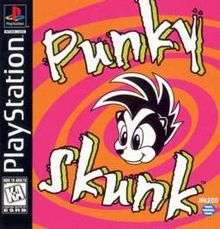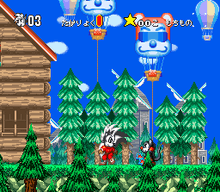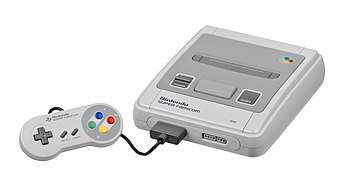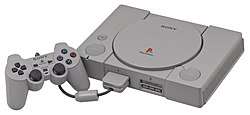Punky Skunk
Punky Skunk[lower-alpha 1] is a side-scrolling action-platform video game developed by Ukiyotei and published by Visit in Japan on 1 November 1996 and later by Jaleco in North America in February 1998 exclusively for the PlayStation.[1][2] Taking place on a set of island archipiélagos where the wolf Badler and his legion of mouse-like Chews are threatening to pollute the locations through industries and machinery, players assume the role of the titular main protagonist in an attempt to overthrow Badler and his BB Brigade army with the help of his companions Nash and Kelly. Its gameplay mainly consists of platforming using a main three-button configuration.
| Punky Skunk | |
|---|---|
 North American cover art | |
| Developer(s) | Ukiyotei |
| Publisher(s) | |
| Director(s) | Kaori Naruse |
| Producer(s) | Kazunobu Morimoto |
| Designer(s) | Kenshi Naruse |
| Programmer(s) | Norihiro Tokeshi Satoshi Kuroda Tadakatsu Makiuchi |
| Artist(s) | Midori Nasu Michiyo Komura Rika Ueno |
| Composer(s) | Harumi Fujita Yasuaki Fujita |
| Platform(s) | PlayStation |
| Release | |
| Genre(s) | Action, platform |
| Mode(s) | Single-player |
Punky Skunk was conceived by Ukiyotei founder Kenshi Naruse during his time working at the company, who began creating a mascot action game intended for younger audiences reminiscent of Sony's Skyblazer on the Super Famicom as a commission by Bullet-Proof Software but later settled on doing a new title directed towards western audience with Visit using the same game engine after Bullet-Proof Software changed their direction. The arrival of PlayStation in both eastern and western markets led Ukiyotei with suspending development of the project on Super Famicom before ultimately deciding on making a different version for the former platform, while integrating some of their previously established ideas from the original version into the final release.
Upon its release, Punky Skunk was met with a mostly negative reception, with critics panning its visual presentation, audio and gameplay.
Gameplay
.png)
Punky Skunk is a side-scrolling action-platform game similar to Skyblazer where the player takes the role of an anthropomorphic skunk named Punky, who settles on saving the world with the aid of his friends Nash and Kelly from the evil BB Brigade army led by Badler as the main objective.[3][4][5][6][7]
Throughout the stages, players may find a set of special tools for Punky via a "gear" icon, including a skunk spray, a parasail, a pogo stick, inline skates, digging claws and a snowboard.[3][4][6] Besides the main stages in the game, minigames are also featured which can benefit Punky in his journey with items like extra lives.[3][4][6]
Similar to Super Mario Bros. and Sonic the Hedgehog, there are collectible stars scattered on almost every stage and obtaining 100 of them grants Punky with an extra life.[3] Punky loses a live if he sustains a number of hits or falls of the stage and once all lives are lost, the game is over.[3] Progress in the game is saved via the PlayStation's memory card.[3]
Development
Punky Skunk was the creation of Ukiyotei founder Kenshi Naruse, whose previous works at the company included Hook, Skyblazer and Todd McFarlane's Spawn: The Video Game. Kenshi recounted about the game's development process and history in a 2012 online interview.[8][9][10] Kenshi stated that the title went through various circumstances before its eventual release to market, initially starring a different main protagonist on a mascot action game titled Metamoru Kid Gūmin for the Super Famicom as a commission by Bullet-Proof Software,[11][12][13] who wanted a game intended for younger audiences while Ukiyotei settled on creating a concept reminiscent of Skyblazer but aimed at kids.[8][9][10] Despite work on Metamoru Kid Gūmin being nearly complete, development was later halted due to Bullet-Proof Software changing their direction.[8][9][10]
Ukiyotei started afterwards negotiations with Japanese publisher Visit, who proposed to the team with reusing the same game engine written for Metamoru Kid Gūmin on a new project but the arrival of PlayStation in Japanese markets led Ukiyotei focusing towards the western market of the Super Famicom instead.[8][9] Kenshi claimed that Punky's design and main method of attack were a product of Visit, who told the team that "this incorporated the opinions of North American buyers".[8][9] Although work on the Super Famicom version of Punky Skunk was nearly completed, the launch of the PlayStation in North America and the subsequent decrease in the 16-bit market for Super Famicom titles resulted in suspending its development.[8][9]
Ukiyotei would later propose Visit in resuing Punky and continue development of Punky Skunk on PlayStation, to which the latter agreed at the request of elements such as the visuals matched the system's capabilities.[8][9] The programming team used Punky as research in order to code previous techniques they were able to perform with Super Famicom on PlayStation such as character animation and parallax scrolling, as software development kits for the latter console were deemed to be not suitable for 2D titles, converting several elements from the former version while finishing level design and other aspects during the process.[8][9]
Punky Skunk was created by most of the same team that previously worked on Skyblazer for the Super Famicom at Ukiyotei.[3] Development was helmed by Kaori and Kenshi Naruse acting as directors, with Kenshi also being its sole game designer.[3][8][9] Artists Midori Nasu, Michiyo Komura, Rika Ueno, Sadaki Matsumoto, Tadashi Aoyama and Teruo Nagato were responsible for the character designs and pixel art respectively.[3] Norihiro Tokeshi, Satoshi Kuroda, Tadakatsu Makiuchi, Takeru Yamada and Yasushi Kamiya acted as programmers.[3] Former Capcom composers Harumi and Yasuaki Fujita co-wrote the soundtrack.[3] Visit also collaborated on the project's making as well.[3]
Release

Punky Skunk was first showcased to the public in a playable state on Super Famicom under its Japanese title, Cooly Skunk, at the 1995 Famimaga Earth World show, where an actor in a Punky costume appeared.[14][15] The game was later previewed in gaming magazine such as Famitsu, touting its launch with a 23 February 1996 release date.[16][17][18]
The original Super Famicom version of Punky Skunk was never released due to dying 16-bit markets and the launch of PlayStation in North America.[19] Prior to its cancellation on Super Famicom, a playable demo was broadcast via Satellaview.[9][10][20] In 2019, the demo was discovered on a 8M Memory Pak at the Japanese video game store Super Potato and a ROM image of said demo was later leaked online in January 2020.[9][10]
Punky Skunk was later moved and eventually published on PlayStation by Visit in Japan on 1 November 1996 under the name Cooly Skunk, and later in North America by Jaleco in February 1998.[1][2][21] On December 2, 1999, the game was later re-released as budget title exclusively in Japan.[22]
Reception
| Reception | ||||||||||||
|---|---|---|---|---|---|---|---|---|---|---|---|---|
| ||||||||||||
Punky Skunk was met with mostly negative reviews from critics since its release. Next Generation reviewed the game, rating it one star out of five, and stated that "Nuts to this - you might as well hook up your SNES and play Zero the Kamikaze Squirrel".[25]
Electronic Gaming Monthly criticized the game's marketing for claiming the titular character had attitude, stating Punky was "...a Generation X skunk with an attitude!".[27] The titular character is ranked eighth on Game Informer’s list of "the top 10 worst character names".[28] Ryan Geddes of IGN considered the game and its English title to be equally bad.[29] Screen Rant's Evan Hopkins placed its titular character as number 14 in his "20 video game mascots that tried to dethrone Mario" feature.[30]
Notes
References
- "PlayStation Soft > 1996" (in Japanese). GAME Data Room. Archived from the original on 17 August 2018. Retrieved 19 January 2020.
- "The World's First Stinky Mascot - Jaleco's Punky Skunk should bring mascot-based 2D platforming back to the PlayStation". IGN. Ziff Davis. 24 October 1997. Archived from the original on 20 March 2017. Retrieved 19 January 2020.
- Punky Skunk manual (PlayStation, US)
- "Previews: Punky Skunk - Can a skunk smell the sweet scent of success?". PSM. No. 8. Imagine Media. April 1998. p. 40.
- "Action/Platform Games - Punky Skunk". PSM. No. 16. Imagine Media. December 1998.
- Taborda, Zillion (4 May 2017). "Punky Skunk". Hardcore Gaming 101. Archived from the original on 15 November 2019. Retrieved 26 May 2019.
- "EndGame: Punky Skunk". Retro Gamer. No. 182. Future Publishing. June 2018. p. 114.
- Billscat-socks (2012). "Kenshi Naruse (interview)". hiddenpalace.org. Archived from the original on 29 October 2018. Retrieved 19 January 2020.
- togemet2 (19 January 2020). "Cooly Skunk (SNES, Unreleased)". gamingalexandria.com. Archived from the original on 20 January 2020. Retrieved 19 January 2020.
- Linneman, John (26 January 2020). "Cooly Skunk: how a lost Super NES game was miraculously recovered via satellite download - And how it compares against the revamped PS1 release". Eurogamer. Gamer Network. Retrieved 26 January 2020.
- Auletta, Marco (March 1994). "Made In Japan - Ah-Ah! E Adesso?". Consolemania (in Italian). No. 28. Xenia Edizioni. p. 15.
- "International News: Metamol Kid Goomin (BPS/Super Famicom)". Super Power (in French). No. 19. SUMO Éditions. March 1994. p. 20.
- "International Outlook - CSG (Consumer Soft Group) Show: Metamor Kid Goomin". Electronic Gaming Monthly. No. 59. Sendai Publications. June 1994. p. 86. Archived from the original on 5 January 2019. Retrieved 23 February 2020.
- "The World Of Nintendo: Se celebró en Tokio el FEW 95 - Los nipones se fueron de feria". Nintendo Acción (in Spanish). Vol. 4 no. 36. HobbyPress. November 1995. p. 14.
- Sekai-yusu, Nihon (November 1995). "Super Express - Live From Hell City". Super Play. No. 37. Future Publishing. pp. 24–26.
- "NEW SOFT". Famitsu (in Japanese). No. 351. ASCII. 8 September 1995. p. 217. Archived from the original on 30 May 2019. Retrieved 19 January 2020.
- "ファミコン スペースワールド'95 - クーリースカンク (SF)". Famitsu (in Japanese). No. 363. ASCII. 1 December 1995. p. 104. Archived from the original on 29 May 2019. Retrieved 19 January 2020.
- "News Previews International - Cooly Skunk". Super Power (in French). No. 41. SUMO Éditions. March 1996. p. 9.
- monokoma (8 February 2010). "Cooly Skunk [SNES – Cancelled]". unseen64.net. Archived from the original on 10 August 2016. Retrieved 19 January 2020.
- "サテラビューで配信された体験版・配信版ゲームの一覧 - 新作の体験版". god-bird.net (in Japanese). GOD BIRDゲーム史研究所. 8 February 2010. Archived from the original on 4 July 2018. Retrieved 19 January 2020.
- "PlayStation Previews - Punky Skunk". Electronic Gaming Monthly. No. 102. Ziff Davis. January 1998. p. 88.
- "PlayStation Soft > 1999" (in Japanese). GAME Data Room. Archived from the original on 15 March 2018. Retrieved 19 January 2020.
- Marriott, Scott Alan (1998). "Punky Skunk - Review". AllGame. All Media Network. Archived from the original on 16 November 2014. Retrieved 11 May 2019.
- Rickards, Kelly; Williams, Ken; Ricciardi, John; Smith, Shawn (April 1998). "Review Crew - Punky Skunk". Electronic Gaming Monthly. No. 105. Ziff Davis. p. 100.
- "Finals - Punky Skunk". Next Generation. No. 42. Imagine Media. June 1998. p. 142.
- Tafu (1998). "XFlash - Punky Skunk". Game-X (in Portuguese). Vol. 2 no. 22. Trama Editorial. p. 16.
- "Mascot Hell". Electronic Gaming Monthly. No. 201. Ziff Davis. March 2006.
- "The Top 10 Worst Character Names". Game Informer. No. 188. GameStop. December 2008. p. 22.
- Geddes, Ryan (9 February 2010). "Great Games With Silly Names - Videogames we love, with titles that make us chuckle". IGN. Ziff Davis. Archived from the original on 10 April 2019. Retrieved 19 January 2020.
- Hopkins, Evan (7 February 2019). "20 Video Game Mascots From The 90s That Tried (And Failed) To Dethrone Mario - Super Mario Bros. exploded throughout the 90s, leading many companies to attempt to dethrone the Nintendo mascot". Screen Rant. Valnet, Inc. Archived from the original on 6 March 2019. Retrieved 19 January 2020.

